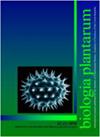参与果聚糖生物合成途径的两个关键基因在洋蓟和野豆蔻中的差异表达改善了菊粉型果聚糖
IF 0.9
4区 生物学
Q4 PLANT SCIENCES
引用次数: 0
摘要
洋蓟(Cynara cardunculus亚种)是一种有趣的不可消化的糖聚合物的来源,如菊糖型果聚糖。朝鲜蓟是传统地中海饮食的重要组成部分,其可食用部分是许多高附加值化合物的良好来源,如菊粉,一种具有相关益生元特性的聚合物。与栽培品种相比,野生cardoon (C. cardunculus var。西尔维斯特(Sylvestris)在恶劣条件下自然生长,并且很好地适应了许多边缘地区,在压力大的土地上有很好的可持续生产潜力。本文采用酶促法测定了洋蓟和野生洋芋中菊粉型果聚糖在不同器官(头和根茎)中的含量。对参与果糖生物合成的两个关键酶蔗糖1-果糖基转移酶和葡聚糖1-果糖基转移酶的基因表达模式也进行了评价。我们的研究结果表明,菊粉型果聚糖在野生cardoon中的含量高于洋蓟头中的含量,并且参与果聚糖生物合成途径的两个关键基因的表达也更高。在根茎中还发现了显著含量的菊粉型果聚糖,支持这些化合物在储存和抵御寒冷和/或冬季胁迫方面的重要作用。本文章由计算机程序翻译,如有差异,请以英文原文为准。
The differential expression of the two key genes involved in fructan biosynthetic pathway in artichoke vs. wild cardoon improves inulin-type fructans
The artichoke ( Cynara cardunculus subsp. scolymus ) is an intriguing source of indigestible sugar polymers such as inulin-type fructans. Artichoke represents an important component of a traditional Mediterranean diet and its edible parts are a good source of many high added value compounds such as inulin, a polymer showing relevant prebiotic properties. Compared to the cultivated varieties, the wild cardoon ( C. cardunculus var . sylvestris ) growing naturally under harsh conditions and well-adapted to many marginal areas, could have a good potential for use in sustainable production in stressed lands. Here, we evaluated by enzymatic assay, the amount of inulin-type fructans both in artichoke and wild cardoon in the two different organs, heads and rhizomes. The expression pattern of the genes encoding the two key enzymes sucrose:sucrose 1-fructosyltransferase and fructan 1-fructosyltransferase, involved in fructan biosynthesis, have been also evaluated. Our results showed that the amount of inulin-type fructans was higher in the wild cardoon than in the artichoke heads, together with a higher expression of the two key genes involved in the fructan biosynthetic pathway. A conspicuous content of inulin-type fructans was found also in the rhizome, supporting the significant role of these compounds in the storage and in protection from cold and/or winter stresses.
求助全文
通过发布文献求助,成功后即可免费获取论文全文。
去求助
来源期刊

Biologia Plantarum
生物-植物科学
CiteScore
2.80
自引率
0.00%
发文量
28
审稿时长
3.3 months
期刊介绍:
BIOLOGIA PLANTARUM is an international journal for experimental botany. It publishes original scientific papers and brief communications, reviews on specialized topics, and book reviews in plant physiology, plant biochemistry and biophysics, physiological anatomy, ecophysiology, genetics, molecular biology, cell biology, evolution, and pathophysiology. All papers should contribute substantially to the current level of plant science and combine originality with a potential general interest. The journal focuses on model and crop plants, as well as on under-investigated species.
 求助内容:
求助内容: 应助结果提醒方式:
应助结果提醒方式:


